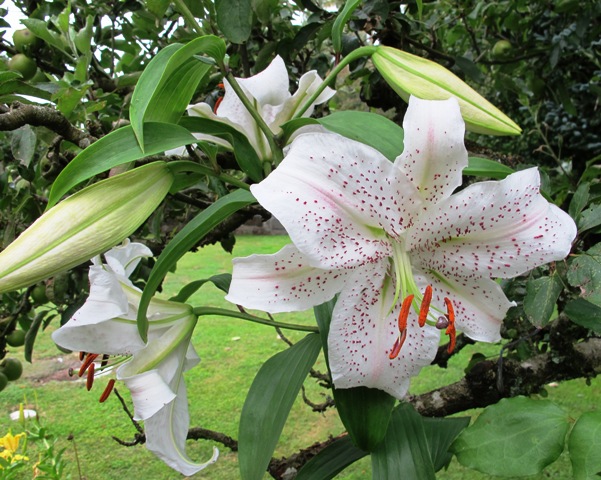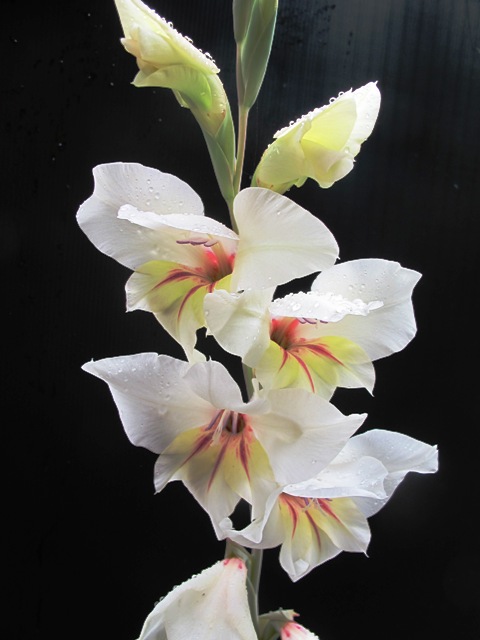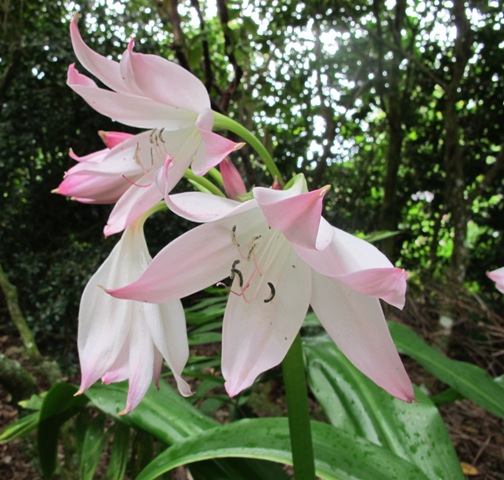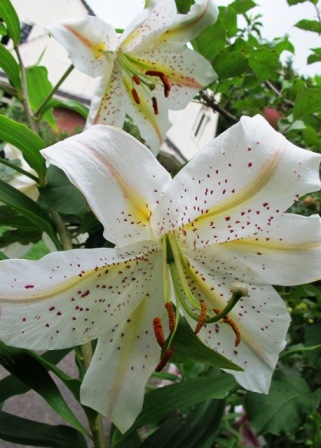
Auratum lilies in the summer border
Flowers mark the seasons for gardeners. To us, autumn means nerines. Winter is for camellias, late winter brings snowdrops, bluebells and magnolias. Spring means rhododendrons and cherry trees. And summer? Lilies are the flowers of summer.
Not roses. They look wonderful in late spring but by the time summer arrives, the roses are past their best. They tend to be happier in drier climates with low humidity, often with the advantage of cold winters to kill greeblies and fungi. To keep them looking good in warm, moist climates with high humidity requires a rigorous spray programme and good management. It can be done but we don’t do it.
But the lilies need no such fuss and they reward us with masses of blooms throughout the summer season, though to have a succession of them, you need to grow a range of different types. Fortunately there are plenty to choose from. There are well over 100 different species and that does not include the hybrids. Nor will I sidetrack onto plants that are referred to as lilies by name but are not lilies by nature – zantedeschia or arum lily, gloriosa or climbing lily, let alone daylilies and waterlilies.
We start with what we call the Christmas lily which is Lilium regale. It is a fragrant trumpet lily from China which is flushed deep red on the backs of the petals and is usually in flower for me to pick for the Christmas table. If you are thinking of a pure white Christmas lily (much favoured by florists), you are probably referring to Lilium longiflorum which hails from Japan. The renowned madonna lily, with its pure white trumpets, is yet another species (candidum) from southern Europe but it is distressingly prone to virus.

The Aurelian lilies are an earlier flowering favourite
Dovetailing with the Christmas lily, we have some lovely, sweetly scented trumpet lilies of the Aurelian type. These are a personal favourite. I love the soft honey apricot and lemon colours of the ones we have here and they are easy to grow in a garden border. Like most lilies, they pick well.

The tiger lilies lack scent but are easy to grow
The tiger lilies are pretty common and dead easy to grow but they lack scent, which can be a bit of a disappointment. If you can overlook that deficiency and you garden with orange tones, these lilies are perfect in mixed plantings. They rarely need staking and after flowering, the foliage dies down pretty quickly. The petals are described as reflex – in other words they curve backwards, not unlike a crown. There are a number of other lilies with this flower form (referred to as Turk’s cap lilies because they resemble a Turkish headpiece), but the tiger lily is in fact Lilium lancifolium, sometimes referred to as Lilium tigrinum. We don’t find the proper Turk’s caps (being L. martagon) anywhere near as easy to grow. If you know someone with tiger lilies, they produce masses of tiny bulbs (called bulbils) on the lower stem and these will reach flowering size in a couple of years.
All these lilies are but the prelude to the extended display we get from the astounding auratums. I wrote about these in Plant Collector over a month ago, the wonderful golden rayed lilies of Japan. They are still in full flight here and a major feature of the summer garden. They are big. They are beautiful. They are very fragrant. One might consider they are a bit over the top – but never vulgar. If planted by a path, they will need staking to stop every passerby being touched with golden pollen. Similarly, when a clump gets too congested, they will be inclined to fall over, unless staked. In garden borders or beds of tidy, compact little plants, the auratums will look out of place. But in big borders with big plants, they are superb. For us, they are the number one flower of summer.
The final flurry for the season comes from the late summer Lilium formasanum, which geographically inclined readers will understand means that these are indigenous to Taiwan. This is another scented trumpet type, predominantly white often flushed rosy pink on the petal backs, generally unfussy and commonly seen in gardens. Formasanum will seed down readily (too readily, some say, but we have never found it a problem) and grow even in semi shade and open woodland areas of the garden. It will flower in just its second year from seed. It makes a particularly good garden subject because its foliage is light and fine so it is not too intrusive in the dying down stages and it does not usually need staking.

I pick lilies to bring indoors. I love the way just one stem can scent an entire room for many days on end. Lilies produce the leaves and the flowering stem all on the same spike. It is important to remember when picking that you must leave sufficient stem and foliage for the bulb to continue photosynthesizing. This is how it builds up enough strength for it to flower again next year.
Lily pollen can stain badly. I am guessing florists carefully brush the pollen from each stamen, being careful not to allow any to fall and mark the petals. I nip off the pollen coated tips, leaving the central stamen. It seems a shame but I know from experience that I do not want to be trying to get pollen stains off carpet and upholstery. You have to keep doing it as buds open in the vase but it is a small price to pay for one of the very best cut flowers I can think of. (See comment below – rethinking these actions now.)
First published by the Waikato Times and reprinted here with their permission.

Auratum lilies with lobelias

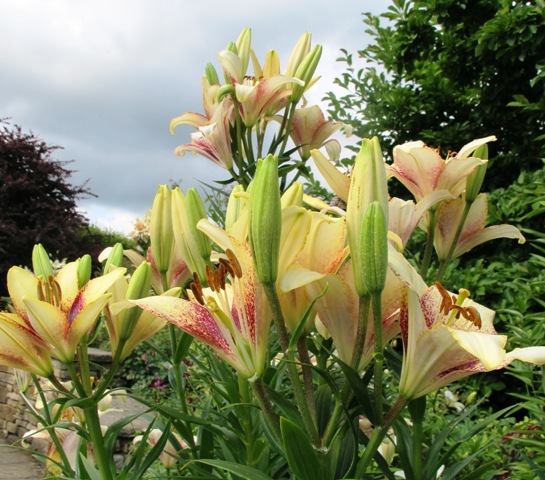

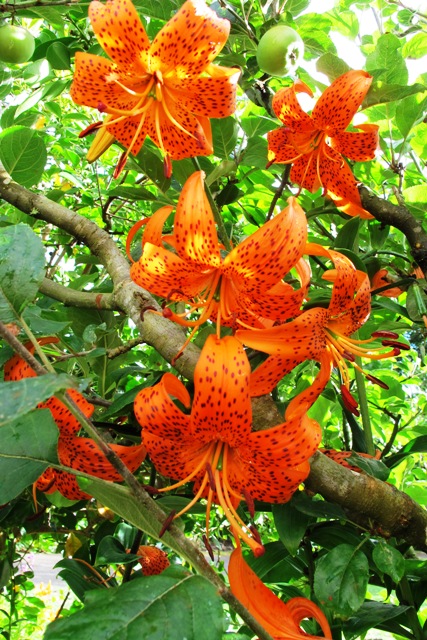

 First published in the New Zealand Gardener and reprinted here with their permission.
First published in the New Zealand Gardener and reprinted here with their permission.


